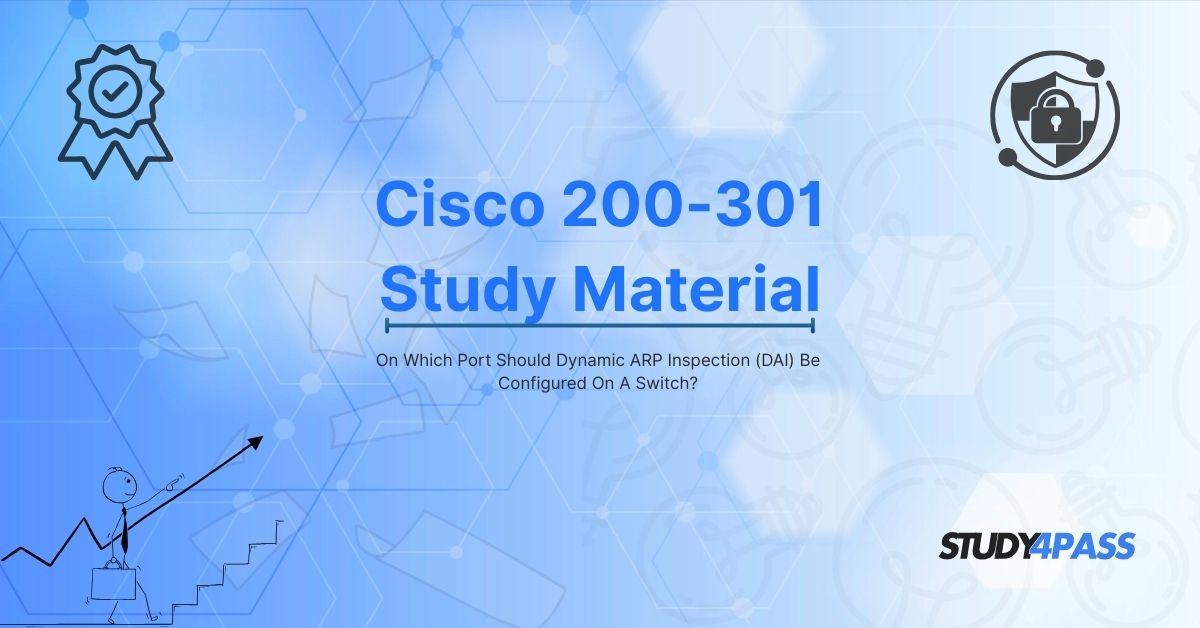Introduction to Dynamic ARP Inspection
Dynamic ARP Inspection (DAI) is a crucial security feature in network switches that helps prevent ARP spoofing and man-in-the-middle (MITM) attacks. As part of the CCNA Security Final Exam (200-301), understanding where and how to configure DAI is essential for network security professionals.
This article explores:
- The importance of DAI in network security
- The correct ports to configure DAI on a switch
- Step-by-step configuration guidelines
- How Study4Pass provides the best study materials for mastering CCNA Security concepts
By the end of this guide, you will have a comprehensive understanding of DAI implementation and how Study4Pass can help you excel in your certification exam.
Understanding Dynamic ARP Inspection (DAI)
What is ARP and Why is it Vulnerable?
The Address Resolution Protocol (ARP) is used to map IP addresses to MAC addresses in a local network. However, ARP lacks authentication mechanisms, making it susceptible to attacks like:
- ARP Spoofing: An attacker sends fake ARP messages to associate their MAC address with a legitimate IP.
- Man-in-the-Middle (MITM) Attacks: Attackers intercept and alter communications between two parties.
How DAI Works?
DAI validates ARP packets by:
- Checking Against DHCP Snooping Database: DAI relies on DHCP snooping to verify IP-MAC bindings.
- Dropping Invalid ARP Packets: If an ARP reply does not match the trusted DHCP snooping database, the switch discards it.
- Logging Violations: Administrators can monitor and log ARP attacks for further investigation.
On Which Port Should DAI Be Configured?
Trusted vs. Untrusted Ports
When configuring DAI, switch ports are categorized as:
1. Trusted Ports
- Definition: Ports connected to authorized devices (e.g., routers, switches, DHCP servers).
- DAI Behavior: ARP packets from trusted ports are not inspected.
- Configuration Example:
interface GigabitEthernet0/1
ip arp inspection trust
2. Untrusted Ports
- Definition: Ports connected to end-user devices (e.g., PCs, printers).
- DAI Behavior: ARP packets are validated against the DHCP snooping binding table.
- Default Setting: All ports are untrusted unless explicitly configured as trusted.
Best Practices for DAI Port Configuration
- Enable DAI on VLANs: Apply DAI to VLANs where security is critical.
ip arp inspection vlan 10,20
- Trust Uplink Ports: Ports connecting to other switches or routers should be trusted.
- Monitor and Log Violations: Use logging to detect and mitigate ARP attacks.
ip arp inspection validate src-mac dst-mac ip
Step-by-Step DAI Configuration on a Cisco Switch
Step 1: Enable DHCP Snooping
DAI requires DHCP snooping to function correctly.
ip dhcp snooping
ip dhcp snooping vlan 10,20
Step 2: Configure Trusted Ports
Identify and mark trusted ports (e.g., uplink to router).
interface GigabitEthernet0/24
ip dhcp snooping trust
ip arp inspection trust
Step 3: Enable DAI on Desired VLANs
ip arp inspection vlan 10,20
Step 4: Verify DAI Configuration
Check DAI status and statistics.
show ip arp inspection vlan 10
show ip arp inspection statistics
Why DAI is Important for the CCNA Security Exam (200-301)?
The CCNA Security 200-301 exam tests your ability to implement security measures like DAI. Key topics include:
- ARP Spoofing Mitigation: Understanding how DAI prevents attacks.
- Switch Port Security: Knowing trusted vs. untrusted ports.
- Troubleshooting DAI Issues: Analyzing logs and fixing misconfigurations.
Mastering DAI ensures you can secure enterprise networks effectively, a critical skill for network administrators.
How Study4Pass Helps You Master CCNA Security Concepts?
1. Comprehensive Study Materials
Study4Pass offers:
- Detailed CCNA Security Guides: Covering DAI, DHCP snooping, and port security.
- Practice Questions: Simulating real exam scenarios.
- Lab Exercises: Hands-on configuration practice.
2. Expertly Designed Exam Prep
- Updated Content: Aligned with the latest CCNA Security (200-301) syllabus.
- Interactive Learning: Quizzes and flashcards for better retention.
3. Success-Oriented Approach
- Exam Tips: Strategies to tackle DAI-related questions.
- Performance Tracking: Identify weak areas and improve.
Why Choose Study4Pass Over Others?
-
100% Exam-Focused: No irrelevant content—just what you need to pass.
- Trusted by Thousands: High success rates among CCNA candidates.
Final Words
Configuring Dynamic ARP Inspection (DAI) correctly on switch ports is essential for preventing ARP-based attacks. By distinguishing between trusted and untrusted ports, network administrators can enhance security effectively.
For CCNA Security 200-301 aspirants, mastering DAI is crucial—and Study4Pass provides the best resources to ensure Cisco exam success. With expert study materials, practice labs, and real-world scenarios, Study4Pass is your ultimate preparation platform.
Start your journey today with Study4Pass and secure your networking career!
Special Discount: Offer Valid For Limited Time “CCNA 200-301 Certification”
Actual exam question from Cisco's CCNA 200-301 course online.
Sample Questions for Cisco 200-301 Study Guide
1. Why is Dynamic ARP Inspection (DAI) usually configured on switch ports facing end-user devices?
A) To prevent ARP spoofing attacks
B) To increase network bandwidth
C) To disable MAC address learning
D) To enable VLAN hopping
2. Which of the following ports should NOT have Dynamic ARP Inspection (DAI) enabled by default?
A) Ports connected to end hosts
B) Ports connected to other switches
C) Ports connected to DHCP servers
D) Ports connected to routers
3. What is the primary purpose of configuring DAI on a switch?
A) To block unauthorized DHCP servers
B) To validate ARP packets and prevent poisoning attacks
C) To encrypt network traffic
D) To prioritize voice traffic
4. In a typical network, where should DAI be implemented for maximum security?
A) Only on core switches
B) Only on distribution switches
C) On all access layer switches
D) Only on wireless access points
5. Which command is used to enable Dynamic ARP Inspection (DAI) on a Cisco switch port?
A) switchport port-security
B) ip arp inspection trust
C) ip dhcp snooping
D) arp secure


